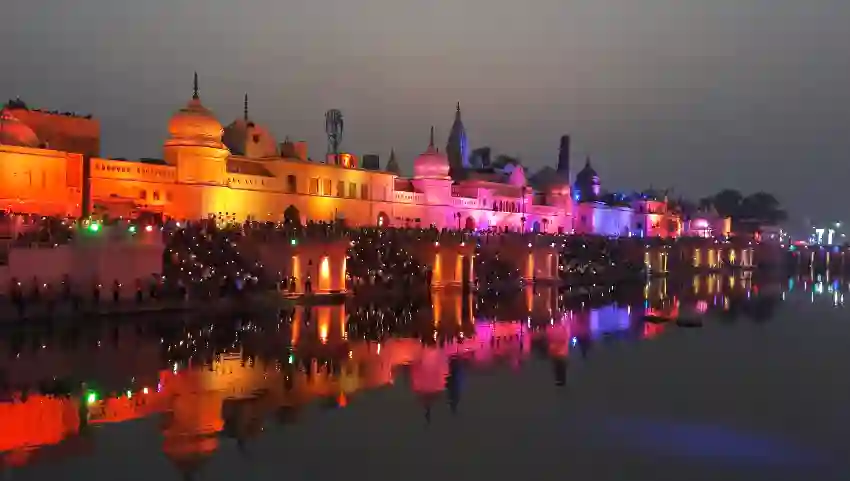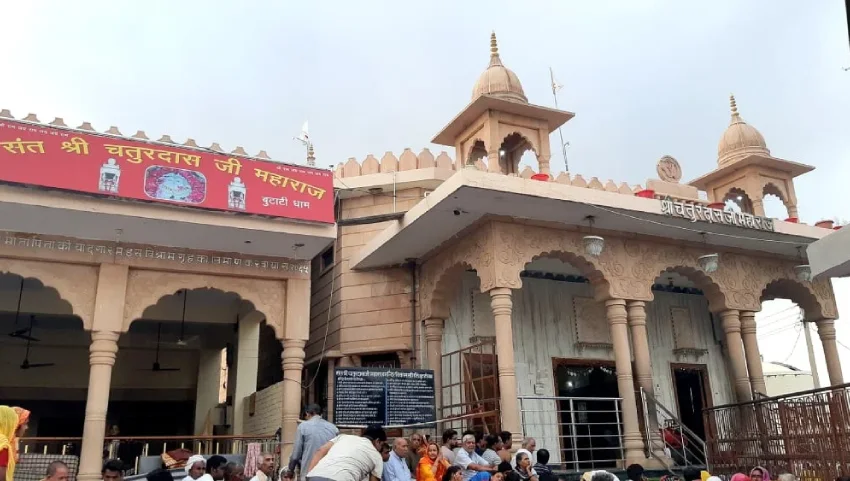
Tourist Places to Visit in Ayodhya
The home of Lord Ram, Ayodhya, is in the state of Uttar Pradesh. Ayodhya, commonly referred to as Ram Janm Bhoomi, is among the top tourist places to visit in Ayodhya, Uttar Pradesh. It is a significant Hindu pilgrimage place and is located on the banks of the sacred Sarayu River. For Buddhists, as much as Hindus, Ayodhya is very important spiritually. Numerous ancient sources have suggested that Gautam Buddha meditated in Ayodhya for numerous years.
Best Places to Visit in Ayodhya
-
1. Ram Mandir
-
2. Hanuman Garhi
-
3. Kanak Bhawan
-
4. Nageshwarnath Temple
-
5. Gulab Bari
-
6. Treta ka Thakur
-
7. Choti Chawni
-
8. Tulsi Smarak Bhawan
-
9. Bahu Begum ka Maqbara
-
10. Raja Mandir
Best Places to Visit in Ayodhya
While you are making an Ayodhya tour package, be sure to visit places such as Treta ke Thakur Temple, Tulsi Samarak Bhawan Museum, Dashrath Mahal, and Sugriva Kila, among others. Check out some of the best places to visit in Ayodhya –
1. Ram Mandir
Ram Janmabhoomi, or the birthplace of Lord Ram, is Ayodhya. Encircling Ayodhya is the Sarayu River, which is revered as a holy river. Hindu pilgrims travel from across the nation to this location, particularly during Ram Navami, to bathe in this sacred river. One of the top attractions in Ayodhya soon will be the Ram Temple. The temple's 28,000-square-foot footprint and 161-foot height make it the largest temple in India. The inauguration is scheduled for 2024. This temple is being built using Ram Shilas, which is one of its most distinctive features.
2. Hanuman Garhi
One of the most significant sites to see in Ayodhya is Hanuman Garhi. As the greatest of Lord Rama's devotees, Hanuman Garhi is the first place devotees who travel to the Ram Nagri will undoubtedly visit. Since it is usual to visit Hanuman Garhi before visiting the Ram Temple here, Hanuman Garhi, a temple dating back to the 10th century, is one of the most popular places in India to visit in honour of Lord Hanuman. Many think that Lord Hanuman resided at the temple location to protect Ayodhya. There is a stunning statue of Lord Hanuman there, perched on his mother Anjani's lap.
3. Kanak Bhawan
The Kanak Bhawan was established towards the northeastern corner of the Ram Janmabhoomi in Tulsi Nagar. Built-in 1891, the temple is also known as Sone ka Ghar. It is a holy site dedicated to the Hindu deity Lord Rama and his wife, Goddess Sita. Kanak Bhawan also means Golden Palace, which is a city with three golden-crowned idols of the two gods under a silver roof in the sanctum santorum. It is believed that this shrine was gifted to Rama and Sita by the former's stepmother, Kaikeyi.
4. Nageshwarnath Temple
The son of Lord Rama, Kush, erected this shrine at Ram ki Paidi. One of the oldest temples in Ayodhya, Nageshwarnath Temple, is devoted to Lord Shiva. One of Lord Shiva's many names is Nageshwar Nath, which translates to "lord of snakes." Every year during Shivratri, Hindu devotees conduct the Shiv Baraat parade and pay homage to this temple. Renowned among Hindu devotees, it is among the most well-known sacred locations in Ayodhya.
5. Gulab Bari
Also known as the Garden of Roses, the Gulab Bari is in Vaidehi Nagar. It is the tomb of the third Nawab of Faizabad, Nawab Shuja-ud-Daula and his parents. The 18th-century structure of this garden brings out pure Nawab-style architecture alongside a vast array of rose species, fountains, and lush greenery.
6. Treta ka Thakur
Located along the Naya Ghat of Ayodhya, the Treta ka Thakur temple houses several idols, including that of Lord Ram, Sita, Lakshman, Hanuman, Bharat, and Sugreev. These statues are said to have been sculpted out of a single black sandstone. It was constructed 300 years ago by Kullu, the king of the time. It is said that the structure stands on the very same ground as the famous Ashwamedha Yagna performed by Lord Rama.
7. Choti Chawni
Choti Chawni, a majestic white marble edifice in Ayodhya, is also known as Valmiki Bhawan or Maniramdas Chawni. This location is quite breathtaking and well worth a visit. There are 34 heritage caves in total; 12 of them are Buddhist, 17 are Hindu, and 5 are Jain. This makes them an important and intricate feat of architectural design.
8. Tulsi Smarak Bhawan
The Ramcharita is thought to have been written by Tulsidas in the Tulsi Smarak Bhawan. The Smarak was constructed in 1969 by Sri Vishwanath Das, the governor of Uttar Pradesh at the time, and is situated near Rajgang Crossing in Ayodhya, on the eastern terminus of the National Highway. The massive library is a storehouse of rich literature; the Smarak also houses a research centre called Ayodhya Research Sansthan.
9. Bahu Begum ka Maqbara
Known as the "Taj Mahal of the East," Bahu Begum ka Makbara is situated on the Maqbara Road in the town of Faizabad. The tallest monument in all of Faizabad, the unusual tomb honouring Queen Bride Begum Unmatuzzohra Bano, the wife and queen of Nawab Shuja-ud-Daula, is renowned for its outstanding non-Mughal architecture. The Bahu Begum ka Makbara is an amazing example of Awadhi architecture, including three domes, delicately constructed interiors, and beautifully crafted walls and ceilings.
10. Raja Mandir
Located on the banks of River Ghaggar (Sarayu) in Guptar Ghar, Raja Mandir in Faizabad has been linked with numerous mythological stories time and again. The temple houses stunningly carved idols of many Hindu Gods and Goddesses, which are ornamentally clad in silken fabrics and rich jewellery. The exquisite construction of the temple reflects the brilliance of the Hindu style of architecture.
Conclusion
Discover the timeless charm of Ayodhya with our exclusive Ayodhya tour package. From sacred temples to historical landmarks, our curated itinerary ensures an enriching experience. Unveil the cultural tapestry and immerse yourself in the spiritual heritage of Ayodhya. Book now for an unforgettable journey.


































